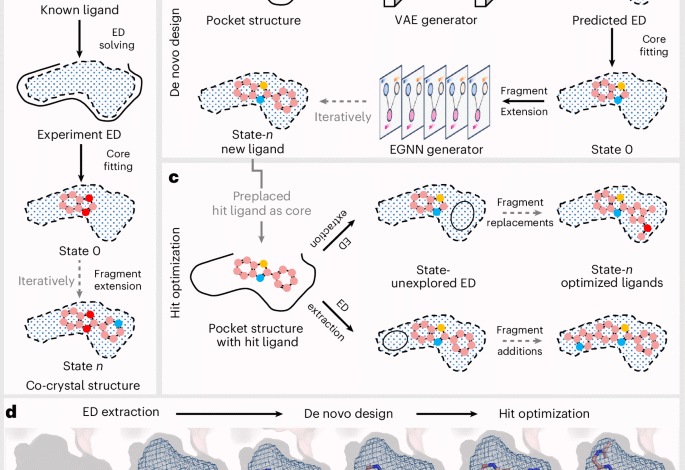Electron-density-informed effective and reliable de novo molecular design and optimization with ED2Mol

Sadybekov, A. V. & Katritch, V. Computational approaches streamlining drug discovery. Nature 616, 673–685 (2023).
Hughes, J. P., Rees, S., Kalindjian, S. B. & Philpott, K. L. Principles of early drug discovery. Br. J. Pharmacol. 162, 1239–1249 (2011).
He, J. et al. ASD2023: towards the integrating landscapes of allosteric knowledgebase. Nucleic Acids Res. 52, D376–D383 (2024).
Irwin, J. J. et al. ZINC20—a free ultralarge-scale chemical database for ligand discovery. J. Chem. Inf. Model. 60, 6065–6073 (2020).
Reymond, J. L. The chemical space project. Acc. Chem. Res. 48, 722–730 (2015).
Schneider, G. & Fechner, U. Computer-based de novo design of drug-like molecules. Nat. Rev. Drug Discov. 4, 649–663 (2005).
Isert, C., Atz, K. & Schneider, G. Structure-based drug design with geometric deep learning. Curr. Opin. Struct. Biol. 79, 102548 (2023).
Li, M., Lan, X., Lu, X. & Zhang, J. A structure-based allosteric modulator design paradigm. Health Data Sci. 3, 0094 (2023).
Harris, C. et al. PoseCheck: Generative models for 3D structure-based drug design produce unrealistic poses. In NeurIPS 2023 Generative AI and Biology (GenBio) Workshop (2023); https://openreview.net/forum?id=Nf5BxVllgq
Buttenschoen, M., Morris, G. M. & Deane, C. M. PoseBusters: AI-based docking methods fail to generate physically valid poses or generalise to novel sequences. Chem. Sci. 15, 3130–3139 (2024).
Jiang, Y. et al. PocketFlow is a data-and-knowledge-driven structure-based molecular generative model. Nat. Mach. Intell. 6, 326–337 (2024).
Pan, Y. Heading toward Artificial Intelligence 2.0. Engineering 2, 409–413 (2016).
Skalic, M., Sabbadin, D., Sattarov, B., Sciabola, S. & De Fabritiis, G. From target to drug: generative modeling for the multimodal structure-based ligand design. Mol. Pharm. 16, 4282–4291 (2019).
Zhung, W., Kim, H. & Kim, W. Y. 3D molecular generative framework for interaction-guided drug design. Nat. Commun. 15, 2688 (2024).
Zhang, Z., Min, Y., Zheng, S. & Liu, Q. Molecule generation for target protein binding with structural motifs. In Eleventh International Conference on Learning Representations (2023); https://openreview.net/forum?id=Rq13idF0F73
Nakatsuji, H. Electron-cloud following and preceding and the shapes of molecules. J. Am. Chem. Soc. 96, 30–37 (1974).
Rico, J. F., López, R., Ema, I. & Ramírez, G. Chemical forces in terms of the electron density. Theor. Chem. Acc. 118, 709–721 (2007).
Terwilliger, T. C., Klei, H., Adams, P. D., Moriarty, N. W. & Cohn, J. D. Automated ligand fitting by core-fragment fitting and extension into density. Acta Cryst. D62, 915–922 (2006).
Mysinger, M. M., Carchia, M., Irwin, J. J. & Shoichet, B. K. Directory of useful decoys, enhanced (DUD-E): better ligands and decoys for better benchmarking. J. Med. Chem. 55, 6582–6594 (2012).
Hopkins, A. L., Keseru, G. M., Leeson, P. D., Rees, D. C. & Reynolds, C. H. The role of ligand efficiency metrics in drug discovery. Nat. Rev. Drug Discov. 13, 105–121 (2014).
Ertl, P. & Schuffenhauer, A. Estimation of synthetic accessibility score of drug-like molecules based on molecular complexity and fragment contributions. J. Cheminform. 1, 8 (2009).
Bickerton, G. R., Paolini, G. V., Besnard, J., Muresan, S. & Hopkins, A. L. Quantifying the chemical beauty of drugs. Nat. Chem. 4, 90–98 (2012).
Schneider, G. & Clark, D. E. Automated de novo drug design: are we nearly there yet? Angew. Chem. Int. Ed. 58, 10792–10803 (2019).
Mozaffari-Jovin, S. et al. Inhibition of RNA helicase Brr2 by the C-terminal tail of the spliceosomal protein Prp8. Science 341, 80–84 (2013).
Iwatani-Yoshihara, M. et al. Discovery of allosteric inhibitors targeting the spliceosomal RNA helicase Brr2. J. Med. Chem. 60, 5759–5771 (2017).
Choi, S.-S., Park, J. & Choi, J. H. Revisiting PPARγ as a target for the treatment of metabolic disorders. BMB Rep. 47, 599–608 (2014).
Artis, D. R. et al. Scaffold-based discovery of indeglitazar, a PPAR pan-active anti-diabetic agent. Proc. Natl Acad. Sci. USA 106, 262–267 (2009).
L’Hote, C. G. & Knowles, M. A. Cell responses to FGFR3 signalling: growth, differentiation and apoptosis. Exp. Cell Res. 304, 417–431 (2005).
Krook, M. A. et al. Fibroblast growth factor receptors in cancer: genetic alterations, diagnostics, therapeutic targets and mechanisms of resistance. Br. J. Cancer 124, 880–892 (2021).
Huang, Z. et al. Structural mimicry of a-loop tyrosine phosphorylation by a pathogenic FGF receptor 3 mutation. Structure 21, 1889–1896 (2013).
Li, M., Rehman, A. U., Liu, Y., Chen, K. & Lu, S. Dual roles of ATP-binding site in protein kinases: orthosteric inhibition and allosteric regulation. Adv. Protein Chem. Struct. Biol. 124, 87–119 (2021).
Attwood, M. M., Fabbro, D., Sokolov, A. V., Knapp, S. & Schioth, H. B. Trends in kinase drug discovery: targets, indications and inhibitor design. Nat. Rev. Drug Discov. 20, 839–861 (2021).
Chu, W. T., Chu, X. & Wang, J. Binding mechanism and dynamic conformational change of C subunit of PKA with different pathways. Proc. Natl Acad. Sci. USA 114, E7959–E7968 (2017).
Melendez, J., Grogg, M. & Zheng, Y. Signaling role of Cdc42 in regulating mammalian physiology. J. Biol. Chem. 286, 2375–2381 (2011).
Maldonado, M. D. M. & Dharmawardhane, S. Targeting Rac and Cdc42 GTPases in cancer. Cancer Res. 78, 3101–3111 (2018).
Jahid, S. et al. Structure-based design of CDC42 effector interaction inhibitors for the treatment of cancer. Cell Rep. 39, 110760 (2022).
Matschinsky, F. M., Glaser, B. & Magnuson, M. A. Pancreatic beta-cell glucokinase: closing the gap between theoretical concepts and experimental realities. Diabetes 47, 307–315 (1998).
Grimsby, J. et al. Allosteric activators of glucokinase: potential role in diabetes therapy. Science 301, 370–373 (2003).
Nishimura, T. et al. Identification of novel and potent 2-amino benzamide derivatives as allosteric glucokinase activators. Bioorg. Med. Chem. Lett. 19, 1357–1360 (2009).
Mitsuya, M. et al. Discovery of novel 3,6-disubstituted 2-pyridinecarboxamide derivatives as GK activators. Bioorg. Med. Chem. Lett. 19, 2718–2721 (2009).
Jiang, X. et al. GPRC5A: an emerging biomarker in human cancer. Biomed. Res. Int. 2018, 1823726 (2018).
Abramson, J. et al. Accurate structure prediction of biomolecular interactions with AlphaFold 3. Nature 630, 493–500 (2024).
Huang, W. K. et al. AlloSite: a method for predicting allosteric sites. Bioinformatics 29, 2357–2359 (2013).
Atz, K. et al. Prospective de novo drug design with deep interactome learning. Nat. Commun. 15, 3408 (2024).
Hert, J., Irwin, J. J., Laggner, C., Keiser, M. J. & Shoichet, B. K. Quantifying biogenic bias in screening libraries. Nat. Chem. Biol. 5, 479–483 (2009).
Mnih, V. et al. Human-level control through deep reinforcement learning. Nature 518, 529–533 (2015).
Cremer, J., Le, T., Noe, F., Clevert, D. A. & Schutt, K. T. PILOT: equivariant diffusion for pocket-conditioned de novo ligand generation with multi-objective guidance via importance sampling. Chem. Sci. 15, 14954–14967 (2024).
Grosse-Kunstleve, R. W., Sauter, N. K., Moriarty, N. W. & Adams, P. D. The Computational Crystallography Toolbox: crystallographic algorithms in a reusable software framework. J. Appl. Crystallogr. 35, 126–136 (2002).
Ganea, O. et al. GeoMol: torsional geometric generation of molecular 3D conformer ensembles. Adv. Neural Inf. Process. Syst. 34, 13757–13769 (2021).
Li, W. & Godzik, A. Cd-hit: a fast program for clustering and comparing large sets of protein or nucleotide sequences. Bioinformatics 22, 1658–1659 (2006).
Gao, M. & Skolnick, J. APoc: large-scale identification of similar protein pockets. Bioinformatics 29, 597–604 (2013).
Riniker, S. & Landrum, G. A. Better informed distance geometry: using what we know to improve conformation generation. J. Chem. Inf. Model. 55, 2562–2574 (2015).
Francoeur, P. G. et al. Three-dimensional convolutional neural networks and a cross-docked data set for structure-based drug design. J. Chem. Inf. Model. 60, 4200–4215 (2020).
Zha, J., Li, M., Kong, R., Lu, S. & Zhang, J. Explaining and predicting allostery with allosteric database and modern analytical techniques. J. Mol. Biol. 434, 167481 (2022).
Akbar, R. & Helms, V. ALLO: a tool to discriminate and prioritize allosteric pockets. Chem. Biol. Drug Des. 91, 845–853 (2018).
Huang, W. et al. ASBench: benchmarking sets for allosteric discovery. Bioinformatics 31, 2598–2600 (2015).
Peng, X. et al. Pocket2Mol: efficient molecular sampling based on 3D protein pockets. In Proc. 39th International Conference on Machine Learning 17644–17655 (PMLR, 2022).
Liu, M., Luo, Y., Uchino, K., Maruhashi, K. & Ji, S. Generating 3D molecules for target protein binding. In Proc. 39th International Conference on Machine Learning 13912–13924 (PMLR, 2022).
Zhang, O. et al. ResGen is a pocket-aware 3D molecular generation model based on parallel multiscale modelling. Nat. Mach. Intell. 5, 1020–1030 (2023).
Guan, J. et al. 3D Equivariant diffusion for target-aware molecule generation and affinity prediction. In Eleventh International Conference on Learning Representations (2023); https://openreview.net/forum?id=kJqXEPXMsE0
Xie, J., Chen, S., Lei, J. & Yang, Y. DiffDec: structure-aware scaffold decoration with an end-to-end diffusion model. J. Chem. Inf. Model. 64, 2554–2564 (2024).
Zhang, Y. et al. FragGrow: a web server for structure-based drug design by fragment growing within constraints. J. Chem. Inf. Model. 64, 3970–3976 (2024).
Kingma, D. P. Adam: a method for stochastic optimization. Preprint at https://arxiv.org/abs/1412.6980 (2014).
Li, M. Electron-density informed effective and reliable de novo molecular design and optimization with ED2Mol. Zenodo https://doi.org/10.5281/zenodo.16736826 (2025).
Li, M. ED2Mol: Electron-density-informed effective and reliable de novo molecular design and optimization with ED2Mol. Github https://github.com/pineappleK/ED2Mol (2025).
Li, M. ED2Mol: electron-density informed effective and reliable de novo molecular design and optimization. Code Ocean https://doi.org/10.24433/CO.7635060.v2 (2025).
Don’t miss more hot News like this! Click here to discover the latest in AI news!
2025-08-20 00:00:00




